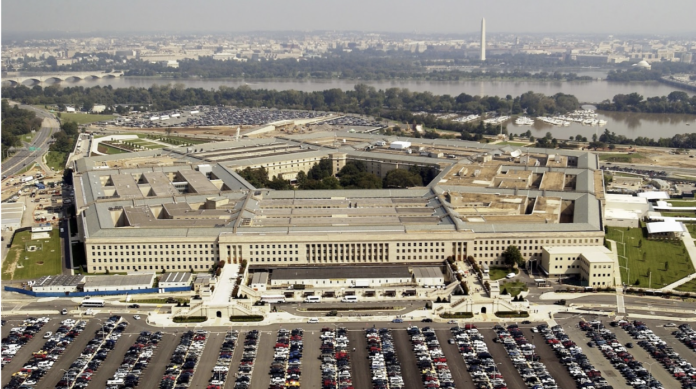![]()
President Biden’s plan for the Fiscal Year 2024 Budget allots $866 billion for U.S. National Defense, a $69 billion increase from Fiscal Year 2023. The 2022 U.S. National Defense Strategy (NDS) outlines four key tenets of deterrence for the U.S. going forward in the era of Great Power Competition (GPC): combat the rise of the People’s Republic of China (PRC), deter acts of aggression against U.S., allies and partners, prepare for future conflict, and continue to bolster the Joint Force capabilities. National Defense spending procures more military assets (i.e., planes, ships, guns etc.), invests in research and development of new military technologies and prioritizes the financial stability of service members and their families.
In the GPC era, it is necessary to remodel, stockpile and reinvest in new and existing military technologies to prepare for future armed conflict. The published national defense budget gives the Pentagon $842 billion. The four NDS tenets guide spending: $246.4 billion for nuclear deterrence and hard power, $146 billion for global U.S. military operations, $145 billion for research and development in new science and technology initiatives, and a 5.2 percent pay raise for military personnel and contractors.
The U.S. nuclear arsenal endures as the best deterrence against critical adversaries. In 2010, the Obama Administration facilitated a cooperative relationship between the U.S. Department of Defense (DOD) and DOE on nuclear modernization programs to maintain American deterrence capabilities in the future. The 2010 Nuclear Posture Review recommitted the U.S. to invest and innovate in its nuclear triad. Fast forward to today, DOE has a $44 billion budget for nuclear weapon modernization programs. The U.S. is investing in weapons technology and security. The LGM-35 Sentinel is a Ground Based Strategic Deterrent (GBSD) Intercontinental Ballistic Missile (ICBM) that will eventually replace the current LGM-30G Minuteman III ICBM. Although in early stages of development, the LGM-35 Sentinel will offer a modern solution to strengthen the land-based U.S. nuclear triad. Nuclear response capabilities will also be strengthened in FY 2024.
Naval reactors will play a crucial role in the U.S. nuclear triad. U.S. Navy aircraft carriers and submarines utilize nuclear power as a fuel source, and they are also the sea component to the U.S. nuclear triad. Thus, the U.S. Navy is continuing research and development into nuclear refuel and defuel capabilities as well as a new Columbia Class ballistic submarine reactor system. With these nuclear innovations, the U.S. Navy is slated to upgrade its fleet with three new nuclear-powered submarines and six new warships.
The U.S. Joint Force combines the Navy, Army, Marine Corps, Air Force, Coast Guard and Space Force against U.S. adversaries. The Joint All Domain Command and Control (JADC2) is a joint-service venture that merges sea, air, land, space and cyber operation capabilities. JADC2 is the command tasked with implementing standardized military communication and data-sharing procedures within the Joint Force. FY 2024 allocates $1.4 billion to JADC2. According to senior military officials, JADC2 is the future of the Joint Force fighting capability and its investment will increase in the coming years.
Finally, FY 2024 allocates almost $3.3 billion for programs to take care of U.S. service members and their families. Most funding will work to make family housing safe and of high quality. $637 million will be used for sexual assault and prevention programs. Other notable programs include child-care services, education services, housing allowances and commissary price reductions. Additionally, another $26 billion will be used for divorce services, parental leave, fitness initiatives and veteran healthcare.
The defense budget provides the federal government with new stuff, but there is a justified concern for the sheer magnitude it; critics probe U.S. lawmakers on the endurance of the military-industrial complex, over-priced defense contracts and the presence of war hawks in Congress.
These concerns are justified. However, the U.S. must maintain its current course on military spending to prepare for GPC. This is not to say that the U.S. should continue to invest in military technologies that have yet to see tactical benefits. Take the U.S. Navy and the Littoral Combat Ships (LCS). The LCS was commissioned in 2008, however, since then, cost overruns and lack of technology have demonstrated failure to adapt and innovate. LCS deployment represents a transition for the U.S. Navy in that it was caught between a plethora of emerging, not fully developed technologies and platforms. Because of this, the LCS experiment has not been as successful as planned. FY2024 decommissions two LCSs after nine years of service, an alarmingly short service life.
Rather than embarking on another ‘LCS journey’, U.S. lawmakers need to work more closely with military flag officers and ground commanders to better understand the needs of the military at the tactical level. Stronger relationships between lawmakers and ground-force commanders could lower excess National Defense spending and provide servicemembers with the resources and technology they will utilize during combat.
To distinguish between excessive and essential military technology and investment, the U.S. should continue to utilize its experienced military NCOs and Officers, academic institutions and independent organizations. In the current ”peacetime” military, there is a unique opportunity to test new technologies, grade their effectiveness and move forward with those that add to the Joint Force capability. The U.S. must remain flexible in its current research and development programs to ensure readiness when the U.S. is called to defend itself vice the rise of malign international actors.
All of this suggests it is vital for the U.S. to continue its adherence to its National Defense Strategy and maintain the readiness of its Joint Force. As the war in Ukraine rages on, China continues to increase its influence in the Indo-Pacific and Africa and regional powers like Iran and North Korea continue to threaten global security, the U.S. National Defense budget represents a recommitment to America’s founding principles as being the world’s provider of peace, protector of liberty and voice of morality. In the budget’s adherence to the U.S. NDS, the new budget is not only justified but necessary.












